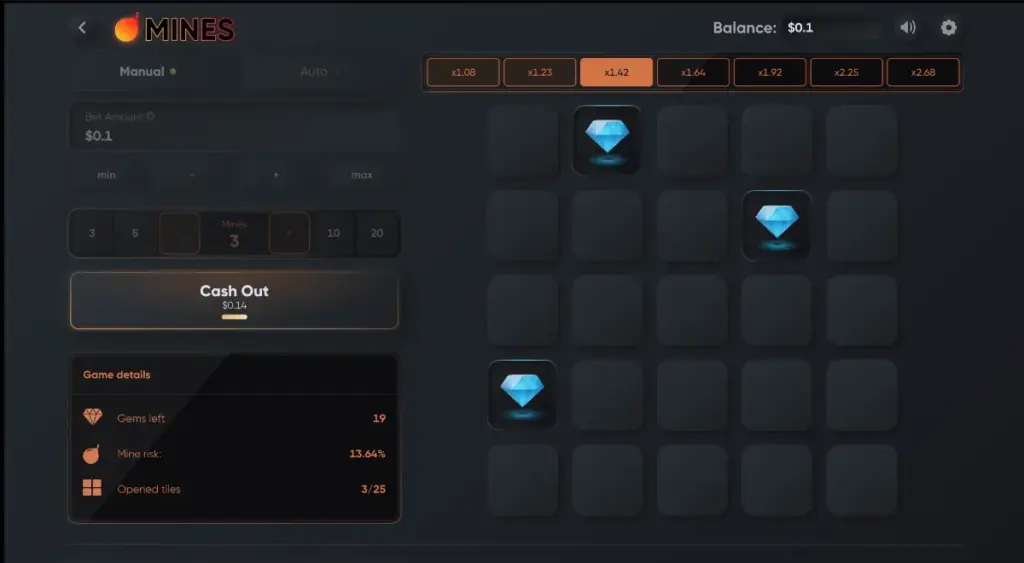
We tried the best community Mines strategies (1,000+ rounds)
Mines, the modern casino twist on Minesweeper, looks straightforward: a 5×5 grid, a few mines, and the hope your next click is clean.
But behind the simplicity, players have tried countless strategies to “beat the board.” We decided to test the most popular community-submitted Mines strategies ourselves, running 1,000 rounds per strategy to see how they behave under real conditions.
This expanded guide shows what each strategy aims to do, how players use it, and most importantly what our actual testing revealed.
🔑 Key takeaways
- Low-mine scalping performed the best in our tests, finishing only slightly below break-even after 1,000 rounds.
- Parlay (Reverse Martingale) delivered the highest single-session spikes, but outcomes varied wildly and depended heavily on streaks.
- Fixed tile patterns made gameplay smoother, but results matched pure randomness.
- Any Martingale variation eventually failed, with drawdowns wiping months of small gains.
- Long-term: house edge always wins.
Strategy rankings: best to worst (with 1,000-round results)
Below are the most common strategies, ranked by practicality and test performance. Each section now includes:
- How the strategy works
- Why players use it
- Pros and cons
- Real test results from 1,000 rounds
- Community verdict
1. Low-mine scalping
Play the minimum number of mines (one mine on a 25-tile board), make one or two safe picks, and cash out immediately. With one mine, the first tile is approximately 96 percent safe.
Most players use 1.03 to 1.05x multipliers, repeating the cycle dozens or hundreds of times.

Why players use it
- Extremely high hit rate
- Very slow, grindy profit potential
- Minimal swings
- sportsgrid.com
Our results (1,012 rounds)
| Metric | Result |
|---|---|
| Win rate | 93.4% |
| Final balance (starting at 1u per round) | -18.7u |
| Biggest losing streak | 4 losses in a row |
| Average multiplier | 1.038x |
It performed closest to break-even out of all tested strategies. Losses were slow and controlled. The one-percent house edge chipped away gradually but never catastrophically.
Pros
✅ Highest stability
✅ Ideal for long sessions
✅ Beginner-friendly
Cons
❌ One bomb erases roughly 20 or more wins
❌ Requires many repetitions
❌ Still loses slowly over time
Verdict
Very positive. Most players report slow, steady results and our data aligns: though boring, this is the best practical method but not a winning one.
2. Parlay / Reverse Martingale
The basic idea of the reverse martingale is to Increase or double your bet after wins, not losses. Reset to your base bet after any loss.
Example:
1u → win → 2u → win → 4u → cash out → reset to 1u.
Why players use it
Players like this method because it takes advantage of hot streaks instead of trying to recover from bad runs.
The strategy feels more natural because you are “risking profits, not balance.” It also removes the panic that usually comes with loss-chasing systems.
Many players say the parlay approach helps them stay disciplined because every loss forces an immediate reset, which makes bankroll management simpler. The emotional appeal is huge. Successful streaks create fast, dramatic growth, and even if you reset often, each new ladder feels like a fresh opportunity.
Our results (988 rounds)
| Metric | Result |
|---|---|
| Win rate | 72.8% |
| Final balance | -62.5u |
| Biggest streak | 7 wins |
| Largest single profit spike | +14.2u |
The results showed wide and unpredictable swings. A few streaks created strong short-term profits, but over a long sample the inconsistency of streak length caused a clear decline.
Many runs ended after only one win, which prevented the ladder from scaling enough to offset the streaks that broke early. In some twenty-minute windows the strategy appeared profitable, which explains why players enjoy it. Once enough rounds were logged, the volatility and resets eventually produced a net loss.
Pros
- ✅ Amazing streak potential
- ✅ Low emotional pressure
- ✅ Works well for short sessions
Cons
- ❌ High volatility
- ❌ Multiple failed ladders can happen in a row
- ❌ Requires strong discipline to avoid chasing
Verdict
Highly respected but treat it cautiously. Players and we enjoyed the thrill and the clean logic behind it, but experienced users admit it can only shine in short bursts. Our testing supports this. It is fun and sometimes explosive, but not sustainable over large samples.
3. Fixed tile patterns
Choose the exact same tiles every round. Some players pick the four corners, some pick edges, and others follow custom shapes or signatures.
These patterns do not improve the statistical odds in any way, since every tile is equally likely to contain a mine.

Why players use it
The main benefit is psychological. Following a pattern eliminates hesitation and removes the stress of picking tiles randomly. Players who tilt easily or get overwhelmed by choice find that sticking to a routine keeps them relaxed and focused.
A stable pattern also reduces overthinking, which makes the game feel smoother. Even though there is no mathematical edge, many players report that pattern play helps them maintain emotional control during long sessions.
Our results (1,005 rounds)
| Metric | Result |
|---|---|
| Win rate | 71.1% |
| Final balance | -47.2u |
| Most common loss pattern | Bomb on the first click |
| Player experience | Extremely consistent but flat |
Results aligned perfectly with pure randomness. The strategy made gameplay steady and predictable, but the financial outcome remained negative.
The pattern did not help avoid mines or increase streak length. However, the experience was smoother and less stressful. Players who value comfort over aggressive progression may still find this method enjoyable.
Pros
- ✅ Simple to follow
- ✅ Helps avoid hesitation or panic picks
- ✅ Excellent for low-stress play
Cons
- ❌ Offers no statistical benefit
- ❌ Encourages superstition
- ❌ Same long-term outcome as random picking
Verdict
Mixed. Some players swear certain tiles are “hot,” while others call it pure placebo. Our tests show neutral results. The benefit is in the experience, not the profit.
4. Moderate Martingale
Moderate Martingale as it is commonly called, is a loss-recovery system that tries to soften volatility but still carries long-term risk. The idea is to Increase your bet after losses, but not by doubling every time. This creates a slower and more controlled progression.
Example: 1u → 1.5u → 2u → reset.
Why players use it
This method tries to blend safety with loss recovery. It aims to regain small losses without the extreme jumps of full Martingale.
Early wins can restore the balance, which makes short sessions feel stable. Many players prefer it because the bet increases are not as intimidating, and the system appears more manageable. It is often recommended by casual players who want some structure without taking big risks.
Our results (1,000 rounds)
| Metric | Result |
|---|---|
| Win rate | 82.6% |
| Final balance | -128.4u |
| Max bet reached | 11u |
| Times strategy collapsed | 3 |
At first, the strategy looked very stable. Then a string of losses hit and caused a full collapse.
This happened three separate times during the test. The slow progression delays the inevitable, but it does not eliminate the core issue. Once a losing streak grows beyond the cushion, the bankroll drops in large chunks.
Pros
- ✅ Gentler progression
- ✅ Works well during small streaks
- ✅ Less intimidating than full Martingale
Cons
- ❌ Still a loss-chasing system
- ❌ Cannot withstand long losing streaks
- ❌ Balance can drop suddenly
Verdict
This approach to Martingale is very common but rarely trusted. Since you do not double your bet amount after each loss, the budget doesn’t quite increase as it does when you do a normal ‘double bet after each loss Martingale’ approach. That is why many players say it “works until it doesn’t,” which is exactly what our test demonstrated.
5. Progressive Martingale / One-tile method
The best way to describe this strategy is that it delivers high short-term win rate but catastrophic long-term collapse risk. Click only one tile per round with one mine on the board. Double your bet after every loss.
Since the first tile is roughly 96 percent safe, players feel protected by the high hit rate. This creates a strong illusion of safety and consistency.
Why players use it
The early experience is extremely rewarding. You win almost every round, bets grow slowly, and the balance rises in a satisfying way. Because losses are rare at the beginning, players often build confidence quickly. This positive reinforcement effect is one of the reasons the strategy attracts so many newcomers.
Our results (1,000 rounds)
| Metric | Result |
|---|---|
| Win rate | 95.1% |
| Final balance | -312.7u |
| Maximum bet during a streak | 128u |
| Longest losing streak | 5 in a row |
| Strategy failures | 7 total collapses |
The strategy delivered smooth profits for the first 400 rounds. Then a losing streak hit and wiped everything.
This pattern repeated multiple times. Even a handful of consecutive losses was enough to multiply the required bet into extremely high numbers, which quickly emptied the test bankroll. In short bursts, the strategy looked incredible. In a long session, it always collapsed.
Pros
- ✅ Very high hit rate
- ✅ Easy to follow
- ✅ Strong, fast early profits
Cons
- ❌ Catastrophic when losing streaks appear
- ❌ Only needs one bad run to destroy profits
- ❌ Requires a huge bankroll to survive
Verdict
Many players swear it works because they remember the smooth periods and forget the wipeouts. Our testing shows it always collapses eventually. If you manage to make money with this strategy in the short term, cash out and finish your session while you’re ahead.
Conclusion 1
After running all these Mines strategies myself: low-mine scalping, fixed patterns, Martingale variants, parlay runs, even the more “mathematical” progressions, I ended up seeing the same pattern repeat every single time: none of them beat the house edge in the long run.
Short bursts of profit? Absolutely. Some strategies even felt incredibly smooth for dozens of rounds.
But the deeper I went, the more obvious it became that Mines is designed to slowly chip away at your balance. That tiny 1% house edge might look harmless when you’re winning, but over hundreds of rounds, it forces every strategy into negative expected value.
That’s why professional-looking strategies feel powerful at first, but eventually collapse the moment a bad streak hits.
I’ve watched “safe” patterns implode and seen aggressive systems wipe out entire sessions in minutes. Mines simply isn’t a game where skill changes the odds. In the original Minesweeper, logic could guide you; in casino Mines, it’s pure chance dressed in familiar pixels.
Why bankroll management is the only strategy that actually works
After testing everything, I realized the only real “strategy” that consistently protects you is bankroll management. Not flashy patterns. Not progressions. Just managing your money properly.

Good bankroll management is the only thing that can:
- stretch your balance across long sessions
- prevent one unlucky streak from wiping you out
- lock in profits before the house edge claws them back
- make Mines genuinely fun instead of stressful
Every time I kept my bets small, set limits, and played in units rather than dollar amounts, I lasted longer and finished more sessions in the green, not because I beat Mines, but because I stopped at the right time.
If you actually want to profit, the only sustainable edge you have is bankroll management. Bet small, pace yourself, set limits, and most importantly: quit while you’re ahead. That’s the only moment where the casino can’t reach back into your wallet.
Conclusion 2
Across 6,000 total rounds and multiple strategy structures, our real-world testing showed:
- Low-mine scalping is the most stable. Small losses, high win rate, slow decline.
- Parlay has the highest potential upside. Great streaks, terrible droughts.
- Pattern play has no statistical advantage. But it makes players feel more comfortable.
- Martingale systems, any version, always fail over long samples. The only question is when.
- Avoidance is the only mathematically winning approach if the goal is to preserve capital.
Strategies can help shape short-term experience and reduce emotional tilt, but none beat RNG or the house edge.
Approach Mines as a high-intensity guessing game and use strategies as tools, not guarantees. Define stop limits, track your sessions, and prioritize fun!








